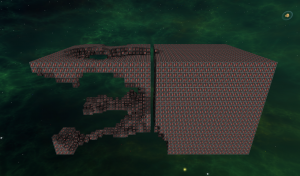Power Auxiliary
| Power Auxiliary | |
|---|---|
 | |
| Hit Points | 50 |
| Armor | 0.0% |
| Mass | 0.10 |
| Luminosity | none |
| Data Value (ID) | 978 |
Power Auxiliaries are a block which add a separate power pool to ships, which can be used for either quick recharging bursts, or a constant increase in power regeneration. This comes with a risk, though: Power Auxiliary blocks which are destroyed will start a chain reaction within their grouping, causing potentially crippling damage if proper precautions were not taken.
Power Auxiliaries are specifically intended for use on larger ships, and are not more efficient than Power Reactors until said blocks have been used to their fullest (approximately 2,000,000 e/sec).
Contents
Item Description
Power Auxiliaries are the result of combining Power Capacitors and |Power Reactors into a single block. Their power regeneration scales similar to the normal power reactors except that only the group count matters and that their soft cap is also per group. They also have the ability to store power internally. You can turn these Auxiliaries "On" and "Off" by toggling it in your weapons menu. - On: Aux regeneration gets added to the main ship, any internally stored power is drained into the main ship's Power Capacitors. - Off: Aux regeneration charges their own internal power storage at a slow rate. WARNING: These blocks are highly volatile! If a group loses a block, it will create an explosive chain event that can destroy an entire reactor group in less than 2 minutes!
Production
| Production Info | |||||
|---|---|---|---|---|---|
| Produced in a | Basic Factory |  |
|||
| Requires | To create | ||||
| Power Reactor Module | x1 |
 |
Power Auxiliary | x1 |
 |
| Power Capacitor | x1 |
 |
|||
Usage
Power Auxiliaries do not have any shape-based grouping bonus, and work best in large, continuous groupings, much like Power Capacitors. However, they also share the same "soft-cap" on effectiveness as Power Reactors, and will become less efficient (in terms of power output per block) when their total regen (while on) approaches 2,000,000.
Power Auxiliaries are off by default, when first placed. In this state, they generate power at 20% of their maximum regen rate (which is reached when they are turned on), and store the generated power in the auxiliary power pool, displayed as an orange bar on the right of the HUD. This pool is separate from the "standard" power pool used by all other ship systems. Although it may seem unintuitive that the system has an "off" state, this has situational relevance as a quick energy resupply after firing an "alpha" weapon (one which has a high damage, high energy cost, and high cooldown); firing such a weapon and then activating the Power Auxiliary system would quickly refill the ship's storage, covering what can otherwise be a temporarily-crippling power usage spike.
When turned on, all power stored in the auxiliary power pool is transferred at a rate equivalent to 25% of the auxiliary pool's total size until the pool is empty. The auxiliaries will continue generating at their maximum rate until turned off again. Because transfer rate is always greater than regen rate, once the auxiliary pool is emptied, effective output of the system becomes equal to its regen rate, rather than the transfer rate.
Although the power generation of an auxiliary reactor is not insignificant, neither is the risk involved in their use. When any block in a Power Auxiliary group is destroyed, a series of explosions will occur throughout that group, with overall severity (quantity, size, and damage of the explosions) being proportional to the block count of the group affected. The explosions occur once every 2 seconds until the given number has been reached. Depending on reactor size and mitigative measures taken (eg. layers or rods of armor throughout the grouping), damage may be either crippling or relatively tolerable.
It is relevant to note that the Power Auxiliary system does not have a computer module available. This means that the entire system is either on or off at any given point, and that individual groupings cannot be toggled on or off. The power capacity of an auxiliary power system is also shared, rather than being confined to invididual groupings.
Formulas
The various details of a Power Auxiliary system are defined by a number of formulas, which are listed below. In many cases, Desmos graphs (an interactive online graphing service) are available to provide a more responsive way to view these formulas. In every case, take care to use only the block count of the grouping in question; using a block count which is the sum of different groupings will not produce a correct result.
| Symbol | Value |
|---|---|
| b | Block count of auxiliary group in question |
| p | Power regen (on) |
| q | Power regen (off) |
| c | Auxiliary power capacity |
| t | Transfer rate from auxiliary to primary power pool |
| n | Number of explosions |
| r | Explosion radius |
| d | Explosion damage |
Power Regen
The regeneration rate (when on), p of a given Power Auxiliary group, is determined by b based on the formula below:
p = 2,000,000 ( 2 / ( 1 + 1.000232 -( 0.00613b )2.25 ) -1 ) + 25b
The regeneration rate (when off), q of a given Power Auxiliary group, is 20% of the grouping's regeneration rate when on.
q = 0.2p
These formulas are displayed on the following Desmos graph.
Power Capacity
The capacity of a given Power Auxiliary, c, is determined by the block count of the Power Auxiliary group in question, b, based on the following formula:
c = 500 * b1.1
Note that because Power Auxiliary groupings are not controlled individually, there is only one auxiliary power pool on a ship, given by the sum of every different groups' capacity.
This formula is displayed on the following Desmos graph.
Transfer Rate
The transfer rate from auxiliary to primary power pools, t, when the Power Auxiliary system is turned on, is 25% of the auxiliary power pool's capacity.
t = 0.25c
Explosions
Three simple formulas determine the statistics of the explosions which affect a Power Auxiliary grouping when part of it is destroyed.
n, the number of explosions which will affect a group upon any of its blocks being destroyed, is equal to 0.5% of that group's block count, b.
n = 0.005b
The result of this calculation is always rounded down to the nearest integer, and is always 1 or greater.
Note that there is a maximum value, 100, for n. This is reached with a group size greater than or equal to 20,000 blocks.
Finally, note that because explosions occur every 2 seconds, the total time which a group will explode for is simply 2n.
r, the radius of the explosions (in meters) which will affect a group, is equal to 0.1% of that group's block count.
r = 0.001b
The minimum value for r is 1 meter, and the maximum value is 8.
d, the damage caused by each explosion in a group, is twice the block count of that group.
d = 2b
The maximum value for d is 100,000, which is reached at a group size of 50,000 blocks.
Efficiency
There are a couple of key factors to pay attention to in designing Power Auxiliary systems efficiently. First and foremost, of course, is efficiency per block (Efficiency = p / b). As Power Auxiliaries use a similar formula to Power Reactors, they lose efficiency after reaching a certain group size. This only applies to power regen, however; power capacity is not capped, and continues to increase at a (small) exponential rate far past the point of useful regen efficiency.
The table below lists a number of block counts and associated regen values, going into more detail around the maximum power/second/block value. Although a Power Auxiliary group of 9,891 blocks has the absolute maximum theoretical efficiency, it is not known to what degree of accuracy Starmade calculates such things, and any relatively similar block count will not vary significantly in efficiency. For example, a Power Auxiliary group of 9,799 blocks will not have much less power per second per block, but will also produce 1 less explosion than a grouping any larger than it, as explained in the next section.
| No. Blocks | Power Regen | Regen/Block |
|---|---|---|
| 1,000 | 38,715.6 | 38.7156 |
| 2,000 | 115,220.9 | 57.61045 |
| 3,000 | 237,103.6 | 79.03453333 |
| 4,000 | 407,887.5 | 101.971875 |
| 5,000 | 626,804.2 | 125.36084 |
| 6,000 | 886,500.3 | 147.75005 |
| 7,000 | 1,170,925.1 | 167.2750143 |
| 8,000 | 1,456,055.4 | 182.006925 |
| 9,000 | 1,715,461.8 | 190.6068667 |
| 9,799 | 1,890,346.6 | 192.9121951 |
| 9,890 | 1,908,133.0 | 192.9355915 |
| 9,891 | 1,908,326.0 | 192.935598 |
| 9,892 | 1,908,518.9 | 192.9355944 |
| 9,999 | 1,928,845.9 | 192.9038804 |
| 10,000 | 1,929,032.9 | 192.90329 |
| 11,000 | 2089310.0 | 189.9372727 |
| 12,000 | 2,201,210.4 | 183.4342 |
| 13,000 | 2,276,555.9 | 175.1196846 |
| 14,000 | 2,328,057.0 | 166.2897857 |
The next consideration in efficient design is to minimize the number of explosions which will occur when part of the group is destroyed. The explosion count is determined by the number of blocks in the group. The table below details this briefly: notice that staying 1 block below the next explosion "level" means getting the most extra blocks possible without also increasing potential damage to the system.
| No. Blocks | No. Explosions |
|---|---|
| 1-399 | 1 |
| 400-599 | 2 |
| 600-799 | 3 |
| 800-999 | 4 |
| 1,000-1,199 | 5 |
Trivia
- Explosions caused by one Power Auxiliary group will not cause another separate Power Auxiliary group to explode.
- Power Auxiliaries were introduced on September 10, 2016, in Starmade V0.199.214[1].
- They were designed as a balanced replacement to the lag-prone player-designed "docked reactors", and the update they were part of rendered such systems defunct[1].
